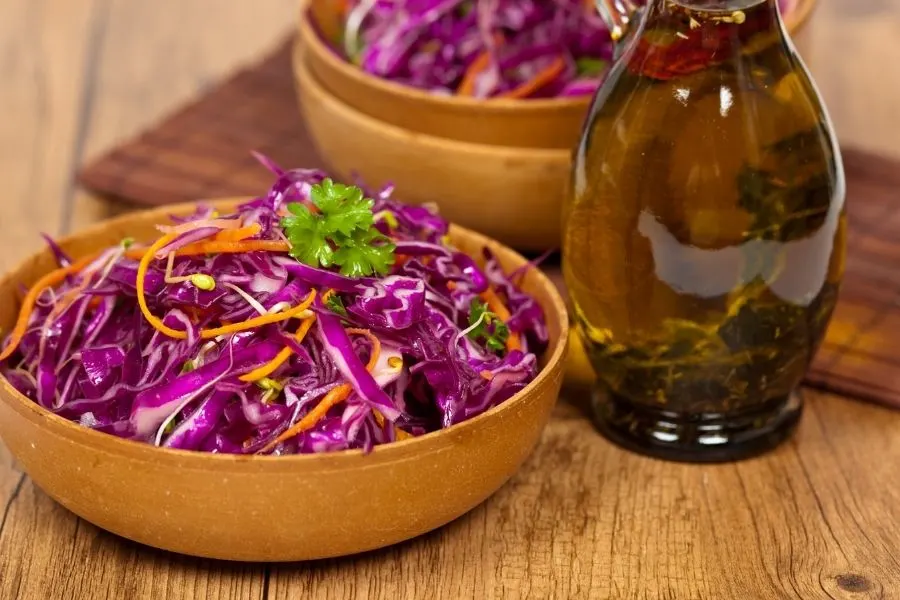Purple cabbage, or red cabbage, is a very pretty version of the everyday green cabbage. It’s got less sulfur flavor, and as such can be considered to be milder by some people. It’s also really impressive to look at, both raw and cooked.
But why is cabbage purple ? What makes it change color ? Is it a natural color or is it dyed that way ? All this and more, coming right up.

Why is cabbage purple ?
Cabbage is purple because it’s a variety that contains a pigment from the anthocyanin family. This pigment slides on the blue-red scale, and produces a varying shades of red, purple, pink, blue, indigo, and so on. Some cabbages may lean more towards red, and some may lean more towards blue-purple.
The soil determines the color
It’s the soil in which the cabbage was planted that determines the exact hue of the vegetable. You see, anthocyanins react to the pH of the soil – alkaline or acidic. A soil that leans more towards acidic will produce a cabbage that’s more towards red. A basic, or alkaline, soil will produce cabbage that is more towards blue or dark purple.
Read also: Best Cabbage Substitutes
There is no real difference between the cabbages that lean more towards red or the ones that lean more towards blue. At least, no real difference in the way they cook and how edible they are.
But the color of the raw cabbage can offer you a hint about the quality of the soil. Generally the more acidic soil has has most of its nutrients stripped in time, and may need more fertilizer. Some plants thrive in this soil, while other need alkaline soil.
Why isn’t green cabbage purple ?
Green cabbage did no evolve to reflect blue-red light, instead it absorbs it completely. It has no anthocyanin, instead it has chlorophyll like most other vegetables. And yes, this means that red cabbage is a bit of a mutation, that humans ended up liking so we developed its own cultivar.
Anthocyanin is found in many fruits and vegetables
You can find anthocyanin in many fruits and vegetables, as it’s a fairly common pigment. Here’s a few examples:
- all berries, including blueberries, blackberries, mulberries, and so on
- cherries and sour cherries
- watermelons, the red part on the inside
- radicchio, the reddish versions
- purple carrots
- red onions and shallots
- black rice
Some flowers derive their colors from anthocyanins. For example the reds, pinks, and purples of pansies come from anthocyanins. Each cultivar/color has been developed through selective breeding, to obtain a consistent color.
In short, you can find this pigment in nature in many plants. You can easily find it in its red form, even purple, but blue is the rarest. This is because the colors we see, as humans, are simply the reflection from the pigments.
Take for example chlorophyll, the most common pigment in plants. It does not absorb the green light wavelength, it instead reflects it. Blue light is the most useful for plants, as it provides the most energy. So very few plants will reflect that blue light.
Their flowers may reflect some blue, and even those are rare. But even those flowers end up with green stems and leaves.
Is red cabbage naturally purple ?
Yes. red cabbage’s color is natural, as its a manifestation of its anthocyanin pigment. However you can change the cabbage’s hue by subjecting it to different pH levels.
For example when you’re sauteeing red cabbage, it tends to brighten and then dull. But if you add a splash of lemon juice or vinegar, it brightens into a beautiful dark pink.

Cabbage is a decent pH indicator
This can come in handy if you’re trying to guess something’s pH and you need a simple way to find out. What you need to remember is that acidic means more red, while alkaline(basic) means more blue.
So adding vinegar to red cabbage will turn it pink. More vinegar, or lemon juice, will turn it more and more pink. If you add some baking soda, it will turn back to purple. if you add even more baking soda, it will eventually turn blue.
Read Also: Why Is Rabbit Meat Not Popular ?
Is purple cabbage a dye ?
Yes, you can use purple cabbage juice as a dye but it’s mostly temporary. After a couple of washes it will be completely gone from your clothes. The fun part is that you can play around with the colors a little.
So for example you stain your white shirt with purple juice, and turn it all purple. Then you drop a bit of lemon juice onto it, to get some dark pink patterns. And then maybe you sprinkle some water with baking soda to get the opposite, blue.
This serves as a nice experiment, especially if you have kids around and want to teach them some applied chemistry.
All in all, red cabbage’s pigment is fun to work with and a really beautiful manifestation of the soil’s nutrients.

